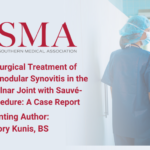Abstract | November 12, 2020
Successful Surgical Treatment of Pigmented Villonodular Synovitis in the Distal Radial Ulnar Joint with Sauvé-Kapandji Procedure: A Case Report
Learning Objectives
- Upon completion of this lecture, learners should be better prepared to discuss the pathology of PVNS and one of the treatment options available for these unique cases.
Introduction: Pigmented villonodular synovitis (PVNS) is described as a rare, benign condition seldomly affecting the wrist, elbow, or hand. Although current literature does not describe a standardized treatment for PVNS, surgical intervention, usually total or subtotal synovectomy, is commonly used to treat the disease. This case is one of the first in evaluating the efficacy of the Sauvé-Kapandji procedure as a treatment modality for PVNS of the wrist.
Case Presentation: A 58-year-old, Hispanic male presented with right wrist pain, worsening for several months and reported an unspecified injury to the wrist approximately 1 year prior. Patient was informed about the procedure and elected to proceed. The procedure went without immediate complications. One-month post operative visit revealed decreased pain and swelling. Four-month visit, the patient experienced no residual paresthesia, brisk capillary refill, and 2/4 peripheral pulses. Passive motion of the wrist: 65o extension, 55o flexion, 45o supination, 80o pronation. Supination markedly limited by heterotopic bone formation confirmed with radiograph. Patient elected for follow up procedure to remove the heterotopic bone formation and has been without complication to date.
Discussion: Estimated annual incidence of PVNS in the United States is approximately 1.8 cases per million patients and less commonly affects smaller joints such as the wrist, which make up about 2.53% of all cases. Likely due to the rarity of the disease, there is no standardized treatment for PVNS. In this case, the decision was made to employ the Sauvé – Kapandji procedure with partial extensor tenosynovectomy.
The Sauvé – Kapandji procedure is a form of arthrodesis for the distal radioulnar joint (DRUJ) and is used to treat a myriad of conditions including various DRUJ instabilities and early synovitis in rheumatoid patients. It was elected for this case because of its increased reliability and durability in treating joint disorders. Although PVNS of the wrist is a relatively rare condition with no current standardized treatment, implementation of the Sauvé – Kapandji procedure can lead to favorable patient outcomes.

